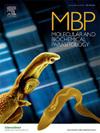Computational investigation of mutations in PfCRT and PfDHFR proteins for emerging resistance of Plasmodium falciparum to antimalarial drugs
IF 1.5
4区 医学
Q4 BIOCHEMISTRY & MOLECULAR BIOLOGY
引用次数: 0
Abstract
The emergence of multidrug resistance in Plasmodium falciparum poses a serious threat to antimalarial treatment, particularly with growing resistance to artemisinin-based combination therapies (ACTs) and partner drugs like piperaquine. Mutations in key proteins, such as PfCRT (P. falciparum chloroquine resistance transporter) and PfDHFR (P. falciparum dihydrofolate reductase), play a critical role in this resistance. Understanding these molecular mechanisms is essential for the development of effective antimalarial therapies. This study aimed to investigate the structural and functional impact of polymorphisms on drug-target interactions and resistance mechanisms in P. falciparum. Molecular docking and molecular dynamics (MD) simulations were performed to analyze interactions of the mutated PfCRT and PfDHFR proteins with nine antimalarial drugs, including piperaquine. The PfCRT-K76A piperaquine complex strong binding affinity (-9.5 kcal/mol) with moderate structural deviation (0.970 ± 0.202 nm) and greater solvent accessibility (246.01 ± 6.135 nm²), suggesting favourable binding conditions. The PfDHFR-N51I–piperaquine complex showed even stronger binding (-10.8 kcal/mol) but higher structural fluctuation (RMSD: 4.491 ± 1.462 nm) and increased compactness (1.861 ± 0.029 nm), which may reflect restricted ligand accommodation and possible resistance. Overall, the findings provide valuable insights into how PfCRT and PfDHFR mutations contribute to drug resistance and establish a foundation for designing more effective antimalarial strategies. Future research should integrate experimental validation and explore additional resistance-associated mutations to develop targeted therapies for combating multidrug-resistant P. falciparum.
恶性疟原虫对抗疟药物产生耐药性的PfCRT和PfDHFR蛋白突变的计算研究
恶性疟原虫多药耐药性的出现对抗疟治疗构成严重威胁,特别是对以青蒿素为基础的联合疗法和哌喹等伴用药的耐药性日益增强。关键蛋白的突变,如PfCRT(恶性疟原虫氯喹耐药转运蛋白)和PfDHFR(恶性疟原虫二氢叶酸还原酶),在这种耐药性中起关键作用。了解这些分子机制对于开发有效的抗疟疾疗法至关重要。本研究旨在探讨恶性疟原虫基因多态性对药物-靶点相互作用和耐药机制的结构和功能影响。通过分子对接和分子动力学(MD)模拟分析突变的PfCRT和PfDHFR蛋白与包括哌喹在内的9种抗疟疾药物的相互作用。PfCRT-K76A哌喹配合物结合亲和力强(-9.5 kcal/mol),结构偏差适中(0.970 ± 0.202 nm),溶剂可溶性较好(246.01 ± 6.135 nm²),结合条件良好。pfdhfr - n51i -哌喹配合物的结合强度更强(-10.8 kcal/mol),但结构波动更大(RMSD: 4.491 ± 1.462 nm),致密度更高(1.861 ± 0.029 nm),这可能反映了配体调节受限和可能的耐药性。总的来说,这些发现为PfCRT和PfDHFR突变如何促进耐药性提供了有价值的见解,并为设计更有效的抗疟疾策略奠定了基础。未来的研究应整合实验验证并探索更多的耐药相关突变,以开发针对耐多药恶性疟原虫的靶向治疗方法。
本文章由计算机程序翻译,如有差异,请以英文原文为准。
求助全文
约1分钟内获得全文
求助全文
来源期刊
CiteScore
2.90
自引率
0.00%
发文量
51
审稿时长
63 days
期刊介绍:
The journal provides a medium for rapid publication of investigations of the molecular biology and biochemistry of parasitic protozoa and helminths and their interactions with both the definitive and intermediate host. The main subject areas covered are:
• the structure, biosynthesis, degradation, properties and function of DNA, RNA, proteins, lipids, carbohydrates and small molecular-weight substances
• intermediary metabolism and bioenergetics
• drug target characterization and the mode of action of antiparasitic drugs
• molecular and biochemical aspects of membrane structure and function
• host-parasite relationships that focus on the parasite, particularly as related to specific parasite molecules.
• analysis of genes and genome structure, function and expression
• analysis of variation in parasite populations relevant to genetic exchange, pathogenesis, drug and vaccine target characterization, and drug resistance.
• parasite protein trafficking, organelle biogenesis, and cellular structure especially with reference to the roles of specific molecules
• parasite programmed cell death, development, and cell division at the molecular level.

 求助内容:
求助内容: 应助结果提醒方式:
应助结果提醒方式:


